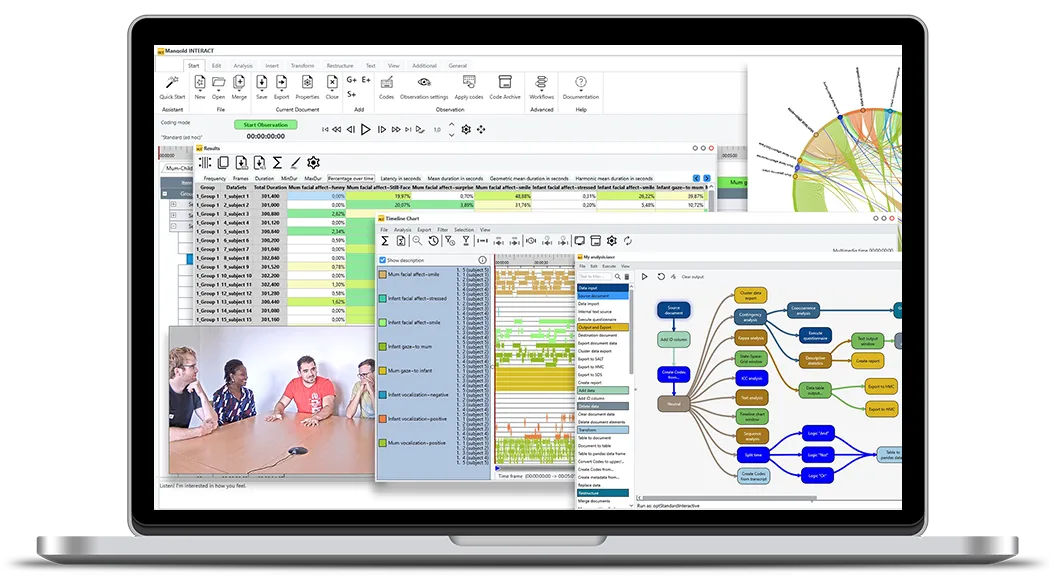Product · 17 min read
Methods of Behavioral Research - A Comprehensive Overview
Unraveling Human Behavior - A Scientific Quest to Understand Why We Do What We Do

Methods of Behavioral Research: A Comprehensive Overview
I. Introduction: Unveiling the Complexity of Human Behavior
The human mind and its intricate behavioral patterns have long been a subject of profound fascination and rigorous scientific inquiry. From the subtle nuances of daily interactions to the grand narratives of societal shifts, understanding why we do what we do is fundamental to addressing complex challenges in psychology, sociology, economics, and beyond. This enduring quest to unravel the mysteries of human actions necessitates a robust and systematic approach, grounded firmly in scientific methods.
In the realm of human behavior research, the application of scientific rigor is not merely an academic exercise; it is a critical imperative. It ensures that our insights are not based on anecdotal evidence or subjective interpretations, but on verifiable, reproducible data. This article embarks on an expedition through the diverse landscape of human behavior research methods, exploring the foundational principles, the distinct quantitative and qualitative approaches, the power of mixed-methods designs, and the cutting-edge technological tools that are shaping the future of this vital field. We will delve into how researchers meticulously collect, analyze, and interpret behavioral data, all while upholding the highest standards of objectivity in research, replicability, and falsifiability, and navigating the crucial ethical considerations in research.

II. The Bedrock of Inquiry: Scientific Methods
At the heart of all credible human behavior research lies the unwavering commitment to the scientific method. This systematic approach provides a framework for generating reliable knowledge, distinguishing it from mere speculation or opinion. Several core tenets underpin this methodology, ensuring the reliability and validity of research findings.
A. Objectivity in Research: Striving for Unbiased Understanding
Objectivity in research demands that investigations are conducted without personal bias, preconceived notions, or emotional involvement influencing the collection, analysis, or interpretation of data. While complete objectivity can be challenging in the study of human behavior, researchers employ various strategies to minimize subjective influences. These include standardized procedures, blind or double-blind experimental designs, and clear operational definitions of variables. The goal is to ensure that findings reflect the phenomena being studied, rather than the biases of the observer.
B. Replicability: Ensuring Consistent Findings
Replicability, also known as reproducibility, is a cornerstone of scientific validity. It refers to the ability of other researchers to independently reproduce the results of a study using the same methods and procedures. If a study’s findings cannot be replicated, their credibility is significantly diminished. This principle encourages transparency in methodology, detailed reporting of experimental protocols, and the sharing of data, allowing the scientific community to verify and build upon existing knowledge. The pursuit of replicability helps to weed out spurious findings and strengthens the confidence in established theories.
C. Falsifiability: The Test of a True Scientific Theory
Introduced by philosopher Karl Popper, falsifiability is the principle that a scientific hypothesis or theory must be capable of being proven false. A theory that cannot, in principle, be disproven by empirical evidence is not considered scientific. This concept drives researchers to design studies that can potentially refute their hypotheses, rather than merely confirm them. For instance, a theory about human aggression must be testable in a way that could demonstrate its inadequacy under certain conditions. This critical approach fosters intellectual humility and continuous refinement of our understanding of human behavior.
D. Ethical Considerations in Research: A Paramount Responsibility
Beyond methodological rigor, human behavior research carries a profound ethical responsibility. Researchers must prioritize the well-being, dignity, and rights of participants. Adherence to ethical guidelines is not just a matter of compliance; it is fundamental to maintaining public trust and ensuring the responsible advancement of knowledge. Key ethical considerations include:
-
Informed Consent: This is a foundational ethical principle requiring that participants are fully informed about the nature, purpose, risks, and benefits of a study before they agree to participate. It must be voluntary, free from coercion, and participants must have the right to withdraw at any time without penalty. This ensures autonomy and respect for individuals.
-
Confidentiality: Researchers are obligated to protect the privacy of participants’ data and personal information. This involves anonymizing data where possible, securing records, and ensuring that individual responses cannot be linked back to specific participants. Maintaining confidentiality builds trust and encourages honest participation, especially when dealing with sensitive topics.
-
Bias Reduction: While objectivity aims to minimize researcher bias, ethical bias reduction extends to the entire research process, including participant selection, data interpretation, and dissemination of findings. Researchers must be vigilant against biases that could unfairly represent certain groups or distort results. This involves careful sampling, diverse research teams, and transparent reporting of limitations.
These ethical considerations are often guided by institutional review boards (IRBs) or ethics committees, which scrutinize research proposals to ensure they meet stringent ethical standards. They serve as a critical safeguard against potential harm and exploitation in the pursuit of scientific understanding.

III. Quantitative Approaches: Measuring and Modeling Behavior
Quantitative research methods in human behavior are characterized by their focus on numerical data, statistical analysis, and the measurement of variables. These approaches aim to quantify behaviors, attitudes, and phenomena, allowing for the identification of patterns, relationships, and cause-and-effect linkages. They are particularly powerful for testing hypotheses and generalizing findings to larger populations.
A. Experimental Research: Uncovering Cause and Effect
Experimental research is the gold standard for establishing causal relationships between variables. In an experiment, researchers manipulate one or more independent variables (the presumed cause) and measure their effect on a dependent variable (the presumed effect), while controlling for other extraneous factors. This controlled environment allows for strong inferences about causality.
Experimental Design: Principles and Applications
Effective experimental design is crucial for the validity of experimental research. Key elements include:
- Random Assignment: Participants are randomly assigned to different experimental conditions (e.g., treatment group vs. control group) to ensure that groups are equivalent at the outset, minimizing pre-existing differences as alternative explanations for observed effects.
- Control Group: A group that does not receive the experimental treatment or receives a placebo, serving as a baseline for comparison.
- Manipulation of Independent Variable: The researcher systematically varies the independent variable across conditions.
- Measurement of Dependent Variable: The outcome variable is precisely measured.
Examples of experimental research in human behavior include studies on the effects of different teaching methods on learning outcomes, the impact of advertising on consumer behavior, or the influence of social media on mood. The rigorous control inherent in experimental designs allows researchers to isolate the effects of specific interventions or stimuli on human behavior.

B. Survey Research: Gathering Insights from Populations
Survey research is a widely used method for collecting data from a large number of individuals through questionnaires or interviews. It is particularly effective for gathering information about attitudes, opinions, beliefs, and self-reported behaviors. Surveys can be administered in various formats, including online, by mail, over the phone, or in person.
1. Cross-sectional Surveys: Snapshots in Time
Cross-sectional surveys collect data from a sample of individuals at a single point in time. They provide a snapshot of a population’s characteristics, attitudes, or behaviors at that specific moment. For example, a cross-sectional survey might assess the prevalence of certain health behaviors in a community or public opinion on a current event. While useful for describing current states and identifying correlations, they cannot establish causality or track changes over time.
2. Longitudinal Surveys: Tracking Change Over Time
In contrast to cross-sectional designs, longitudinal surveys involve collecting data from the same individuals repeatedly over an extended period. This allows researchers to observe changes, identify trends, and explore developmental processes. Types of longitudinal surveys include:
- Trend Studies: Examine changes in a population over time by sampling different groups of individuals at different points in time.
- Cohort Studies: Follow a specific subgroup (cohort) of individuals over time, observing changes within that group.
- Panel Studies: Track the exact same individuals over time, providing the most direct measure of individual-level change.
Longitudinal designs are invaluable for understanding the long-term effects of interventions, the progression of behaviors, or the stability of psychological traits.
3. Descriptive Surveys: Characterizing Populations
Descriptive surveys aim to describe the characteristics of a population or phenomenon without necessarily looking for relationships between variables. Their primary goal is to provide a detailed account of what exists. For instance, a descriptive survey might aim to determine the average number of hours students spend studying per week or the most common forms of stress experienced by employees.
4. Analytical Surveys: Exploring Relationships
Analytical surveys, while also descriptive, go a step further by examining relationships between variables. They seek to explain why certain phenomena occur or how different factors are associated. For example, an analytical survey might investigate the relationship between hours of sleep and academic performance, or between job satisfaction and employee turnover. These surveys often employ statistical techniques to identify correlations and potential predictive relationships.

C. Behavioral Data Collection: Techniques for Quantitative Measurement
Collecting accurate and reliable behavioral data is paramount in quantitative research. Various techniques are employed, depending on the nature of the behavior being studied and the research question. Common methods include:
- Self-report Measures: Questionnaires, surveys, and interviews where individuals provide information about their own behaviors, thoughts, or feelings. While efficient, they can be subject to social desirability bias or recall errors.
- Observational Measures: Direct observation and recording of behaviors, often using structured coding systems. This can involve live observation or analysis of video recordings.
- Physiological Measures: Recording biological responses such as heart rate, skin conductance, brain activity (e.g., fMRI, EEG), or eye movements, which can provide objective indicators of psychological states or responses.
- Archival Data: Utilizing existing records, such as medical charts, school records, or public databases, to extract behavioral information.
Mangold Observation Studio
The advanced software suite for sophisticated sensor data-driven observational studies with comprehensive data collection and analysis capabilities.

D. Behavioral Data Analysis: Statistical Interpretation of Patterns
Once collected, quantitative behavioral data analysis involves the application of statistical methods to summarize, interpret, and draw conclusions from the numerical information. This process allows researchers to identify patterns, test hypotheses, and determine the significance of their findings. Common statistical techniques include:
- Descriptive Statistics: Used to summarize and describe the main features of a dataset (e.g., means, medians, standard deviations, frequencies).
- Inferential Statistics: Used to make inferences about a population based on a sample. This includes hypothesis testing (e.g., t-tests, ANOVA) to compare groups or examine relationships between variables (e.g., correlation, regression analysis).
- Multivariate Analysis: Advanced statistical techniques (e.g., factor analysis, structural equation modeling) used to analyze relationships among multiple variables simultaneously.
The choice of analytical method depends on the research design, the type of data collected, and the specific research questions being addressed. The goal is to transform raw numbers into meaningful insights about human behavior.
IV. Qualitative Approaches: Exploring Depth and Meaning
In contrast to quantitative methods that focus on measurement and numbers, qualitative approaches delve into the richness, complexity, and subjective experiences of human behavior. These methods are particularly valuable for exploring underlying reasons, opinions, and motivations, providing in-depth insights that quantitative data alone might miss. Qualitative research often involves smaller, more focused samples and aims for a deep understanding of specific contexts rather than broad generalization.
A. Observational Research: Studying Behavior in Context
Observational research involves systematically watching and recording behavior as it occurs. This method allows researchers to study behavior in its natural setting, providing valuable context that might be lost in more controlled environments. Observational methods can range from unstructured, exploratory observations to highly structured and systematic recording of specific behaviors.
1. Naturalistic Observation: Unobtrusive Real-World Insights
Naturalistic observation involves observing individuals in their natural environments without any intervention or manipulation from the researcher. The goal is to capture behavior as it naturally unfolds, providing high ecological validity. For example, a researcher might observe children playing in a park to understand social interaction patterns, or study consumer behavior in a retail store. While providing authentic insights, naturalistic observation can be challenging due to lack of control over variables and potential observer bias.
2. Structured Observation: Focused Observation in Controlled Settings
Structured observation involves observing behavior in a more controlled or pre-defined setting, often with specific behaviors or categories in mind. Researchers use coding schemes or checklists to systematically record the frequency, duration, or intensity of particular behaviors. This approach allows for greater comparability across observations and can be used to test specific hypotheses. For instance, a researcher might observe parent-child interactions in a laboratory setting, focusing on specific communication patterns.
B. Case Studies: In-depth Examination of Unique Instances
Case studies involve an intensive, in-depth investigation of a single individual, group, organization, or event. This method is particularly useful for exploring rare phenomena, complex situations, or for generating hypotheses for future research. Case studies often combine multiple data sources, such as interviews, observations, documents, and archival records, to build a comprehensive picture. While providing rich, detailed insights, the findings from case studies may not be generalizable to larger populations due to their unique nature.
C. Ethnographic Research: Immersive Cultural Understanding
Ethnographic research is an immersive qualitative method primarily used in anthropology and sociology, but increasingly adopted in behavioral sciences. It involves the researcher immersing themselves in a particular cultural group or community over an extended period to understand their behaviors, beliefs, and social structures from an insider’s perspective. Data collection typically involves participant observation, in-depth interviews, and analysis of cultural artifacts. The goal is to produce a holistic and nuanced description of the culture or social setting being studied.

D. Grounded Theory: Building Theories from Data
Grounded theory is a systematic qualitative methodology for developing theories directly from data. Unlike traditional research that starts with a hypothesis, grounded theory begins with data collection and then iteratively develops concepts and categories, eventually leading to the emergence of a theory. This inductive approach involves constant comparison of data, coding, memo-writing, and theoretical sampling. It is particularly useful when little is known about a phenomenon or when existing theories are inadequate to explain observed behaviors.
E. Content Analysis: Unpacking Meaning from Textual and Visual Data
Content analysis is a research method used to systematically analyze the content of communication, which can include text, images, audio, or video. It can be quantitative (counting occurrences of specific words or themes) or qualitative (interpreting meanings and patterns). In human behavior research, content analysis can be used to study media representations of certain groups, analyze interview transcripts for recurring themes, or examine social media posts to understand public sentiment. It provides a structured way to make inferences about the producers and audiences of communication based on the messages themselves.
V. Bridging the Divide: Mixed-Methods Research
Historically, quantitative and qualitative research traditions have often been viewed as distinct, even opposing, paradigms. However, a growing recognition of their complementary strengths has led to the rise of mixed-methods research. This approach systematically combines both quantitative and qualitative methodologies within a single study, aiming to provide a more comprehensive and nuanced understanding of complex phenomena than either approach could achieve alone.
A. Combining Quantitative and Qualitative Strengths
Mixed-methods research leverages the strengths of both paradigms. Quantitative data can provide breadth, generalizability, and statistical insights into patterns and relationships, while qualitative data offers depth, context, and rich understanding of experiences and meanings. For example, a study might use a quantitative survey to identify the prevalence of a certain behavior in a large population, and then follow up with qualitative interviews to explore the underlying reasons and experiences associated with that behavior.

B. Benefits and Applications
The integration of methods in mixed-methods research offers several benefits:
- Triangulation: Using different methods to confirm findings, thereby increasing the validity and credibility of the results.
- Complementarity: Elaborating on or clarifying the results from one method with the findings from another.
- Development: Using the results of one method to inform the development of the other method (e.g., qualitative interviews informing the design of a quantitative survey).
- Initiation: Discovering contradictions or new perspectives that lead to new research questions.
- Expansion: Broadening the scope and range of inquiry.
Mixed-methods designs are particularly well-suited for complex research questions in human behavior that require both statistical generalization and in-depth contextual understanding. They are increasingly employed in fields such as public health, education, and social policy, where multifaceted problems demand multifaceted solutions.
VI. The Technological Edge: Tools for Modern Behavioral Research
The landscape of human behavior research has been profoundly transformed by advancements in technology. A new generation of specialized software and systems has emerged, streamlining data collection, enhancing analytical capabilities, and opening up new avenues for understanding complex human actions. These tools not only improve efficiency but also enable researchers to capture and process data with unprecedented precision and scale.
A. Behavioral Research Software: Streamlining Studies
Behavioral research software encompasses a wide array of applications designed to facilitate various stages of the research process. This includes platforms for designing and administering online surveys, creating and managing experimental stimuli, automating data collection in laboratory settings, and even simulating complex social interactions. Such software often integrates features for participant recruitment, data storage, and basic statistical analysis, providing a comprehensive ecosystem for researchers.
B. Observational Coding Software: Enhancing Observational Analysis
For observational studies, observational coding software has become indispensable. These tools allow researchers to systematically code and categorize observed behaviors from video recordings or live observations. Features often include:
- Coding Systems: Customizable libraries of precisely defined behaviors.
- Event Logging: Recording the occurrence of specific behaviors and events.
- Time-stamping: Precisely marking the start and end times of behaviors and events.
- Inter-rater Reliability Analysis: Assisting in assessing consistency among multiple observers.
- Advanced Data Analysis: Support in analyzing the collected codes using descriptive statistics and complex functions to search for patterns and correlations in the recorded data.
This software transforms qualitative observational data into quantifiable metrics, enabling rigorous analysis of behavioral sequences, frequencies, and durations.
INTERACT: One Software for Your Entire Observational Research Workflow
From audio/video-based content-coding and transcription to analysis - INTERACT has you covered.

C. Data Integration Platforms: Unifying Diverse Datasets
Modern behavioral research often involves collecting data from multiple sources and modalities—from self-reports and physiological measures to observational data and social media activity. Data integration platforms are designed to unify these disparate datasets into a cohesive and analyzable format. These platforms can handle large volumes of data, perform data cleaning and transformation, and facilitate the merging of different data types, providing a holistic view of human behavior.
D. Video Analysis Systems: Advanced Behavioral Insights
Video analysis systems represent a powerful technological advancement for studying human behavior. These systems go beyond simple recording, offering sophisticated capabilities such as:
- Automated Facial Expression Analysis: Detecting and quantifying emotions.
- Eye-tracking: Measuring gaze patterns and attention.
- Body Pose Estimation: Analyzing movement and posture.
- Speech and Tone Analysis: Extracting linguistic and paralinguistic cues.
By automating the extraction of subtle behavioral cues from video, these systems provide objective and granular data that would be impossible to capture manually. They are particularly valuable in fields like consumer psychology, human-computer interaction, and clinical research.
These technological tools are not just conveniences; they are fundamentally reshaping the capabilities of human behavior research, enabling more precise measurements, larger-scale studies, and deeper insights into the complexities of human action.
Mangold Observation Labs
Mangold Observation Labs are comprehensive turn-key solution for conducting behavioral research and observation.

VII. Conclusion: The Future of Human Behavior Research
The study of human behavior is a dynamic and ever-evolving field, driven by an insatiable curiosity to understand the complexities of the human experience. As we have explored, this pursuit is firmly anchored in the principles of scientific inquiry, demanding objectivity, replicability, and falsifiability in every investigation. From the controlled precision of experimental design to the immersive insights of ethnographic research, a diverse toolkit of methodologies allows researchers to approach behavioral questions from multiple angles.
Quantitative approaches, including various forms of survey research and rigorous behavioral data collection and analysis, provide the statistical power to identify patterns and generalize findings. Complementing these are qualitative approaches, such as observational research, case studies, grounded theory, and content analysis, which delve into the rich narratives and contextual meanings of human actions. The growing adoption of mixed-methods research further bridges this divide, offering a holistic perspective that combines the breadth of numbers with the depth of lived experience.
Crucially, all these endeavors are bound by a strict adherence to ethical considerations in research, ensuring informed consent, confidentiality, and diligent bias reduction. As technology continues to advance, specialized tools like behavioral research software, observational coding software, data integration platforms, and video analysis systems are empowering researchers with unprecedented capabilities for data capture, analysis, and insight generation.
Looking ahead, the future of human behavior research promises even greater sophistication and interdisciplinary collaboration. The deeper our understanding of the human mind and its interactions with the world becomes, the better we will be able to address pressing societal challenges and foster the global well-being and coexistence of humans, animals, and nature.
INTERACT: One Software for Your Entire Observational Research Workflow
From audio/video-based content-coding and transcription to analysis - INTERACT has you covered.

- Behavioral research software
- Bias reduction
- Content analysis
- Data analysis
- Data collection
- Data integration platforms
- Ethics
- Ethnographic research
- Experiment
- Falsifiability
- Grounded theory
- Mixed-methods research
- Observational coding software
- Qualitative
- Quantitative
- Replicability
- Survey
- Video analysis systems